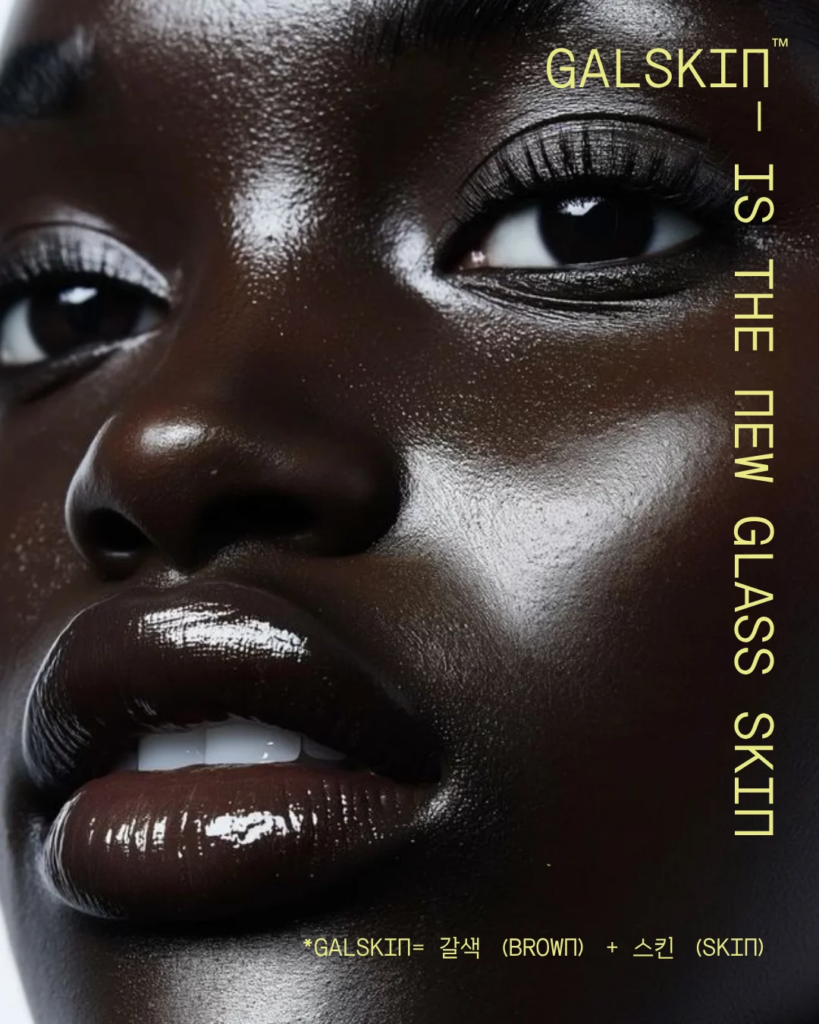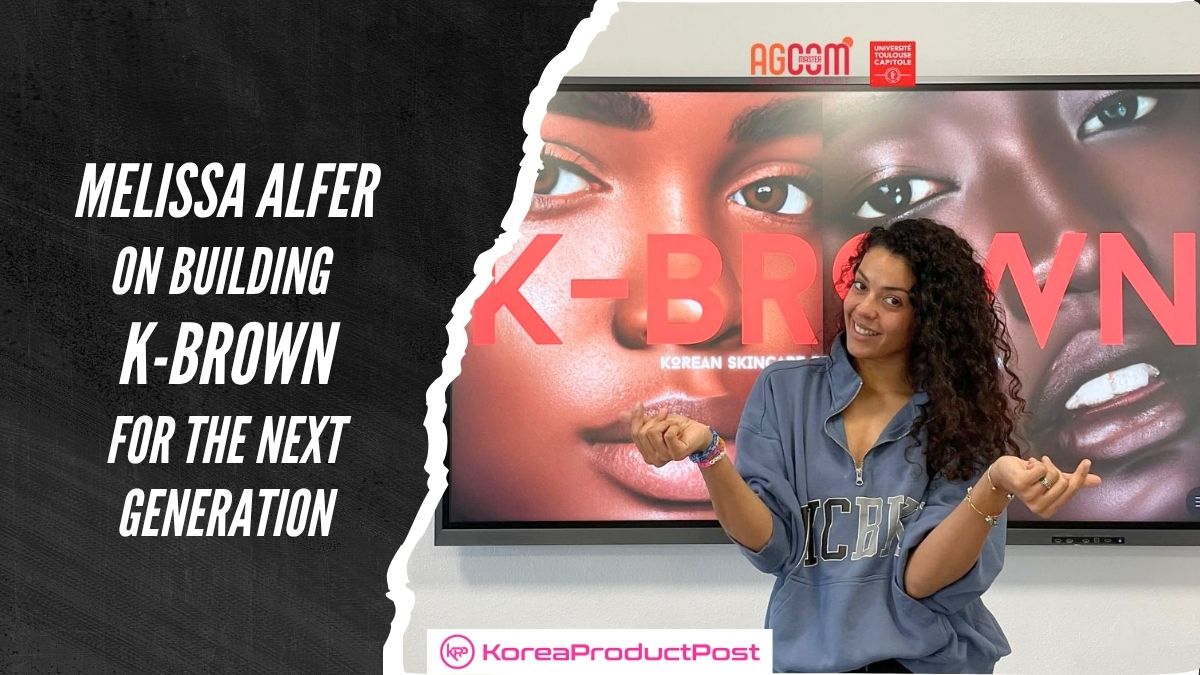K-Beauty may be everywhere, but Melissa Alfer’s K-BROWN stands out! It is the first Korean-made skincare line engineered from day one for “melanin-rich skin prototypes IV, V and VI,” blending Seoul lab speed with clean, vegan, and halal formulas. Currently, Black and Latino shoppers account for roughly a quarter of U.S. K-beauty buyers, but still struggle to find products tested on their tones. To that effect, Alfer is betting that inclusive R&D will be the sector’s next growth engine. Fresh off building a fast-growing waitlist and a vocal LinkedIn micro-community, she joins KoreaProductPost to discuss tariffs, toner, and what it really takes to prioritize deeper skin care.
INTERVIEW
Origin Story and Brand Philosophy
Q. How did you come up with the name K-BROWN? Was it a shower thought, a focus group win, or something else entirely?
Melissa: It just came to me. It felt natural. ‘K’ for K-Beauty and Brown to represent brown skin tones. Some people told me I was being too niche, but I didn’t care. K-BROWN is K-BROWN. We’re creating K-Beauty products for darker skin tones. And I don’t think it’s that niche—many people using K-Beauty products have darker skin. To me, it’s about celebrating the fact that K-Beauty can be for brown skin too. The name just stuck.

Q. Why K-Beauty specifically? Why not J-Beauty, considering Japanese skincare is also popular?
Melissa: Japanese beauty is amazing, but there’s something broader about K-Beauty. It comes with the whole “K-Culture”—K-Pop, K-Dramas. These are hugely popular among consumers with darker skin tones. When you go to a K-pop concert, you see a lot of darker skin tones. K-dramas are very popular in Africa, Latin America, and India, and K-pop is also extremely popular in these regions. So I think there is another layer to K-beauty because it is part of the K-culture world. And I think it was really relevant to go for K-Beauty. There’s a cultural layer that connects. Personally, I love Korea. I’m even moving there soon. So it was a personal decision too.
The Problem with Existing Products
Q. Did you use K-Beauty products before launching your brand?
Melissa: Yes, of course. But, the thing is, it’s the same thing with Western beauty. For darker skin tones, it always feels like gambling, almost. When you buy a product, you never know if it will work or if it will damage your skin. Before starting this journey, I just didn’t know why we had to buy so many products to find one or two that work. And with K-Beauty, there were also these whole whitening claims.
So there are things that you have to check all the time. If an influencer has tried this product, and she has a darker skin tone as well. So I can also try it. For me, it shouldn’t be that hard to consume a product. You know it shouldn’t. It shouldn’t be that much trouble to buy a beauty product.
You know, it took me about six months to actually buy my first beauty product, a real one. I love the layering technique, but I didn’t know which product to start with. If I had K-BROWN at that time, I would have just gone for it, and that’s it.
Some products are good, while others aren’t, as most of them aren’t tested on darker skin tones. Most of them, well, all of them, are not made for us in mind. So, it sometimes works, and sometimes it doesn’t. But it feels like gambling. And I like things to be straightforward. I would say straightforward, easier. I want to make the journey easier.
Product Development and Manufacturing
Q. Are you manufacturing in Korea?
Melissa: Yes. Everything—from formulation to packaging—is developed in Korea. We even partnered with a Korean startup for innovative packaging. Everything is Korean except me and the users!
Q. Korean lab manufacturing is famously fast. Do you foresee any challenges in keeping up with the regulatory paperwork required for Western countries?
Melissa: Not really. My partners are excellent and easy to work with.
The greatest challenge in product development, particularly for beauty brands, lies in claim testing on diverse skin tones. Even internationally, brands typically do not conduct extensive testing on darker skin tones; a panel might include only one or two individuals with such complexions.
This creates a significant hurdle when seeking comprehensive testing. For instance, requesting a full panel of darker skin tones for a simple patch test, which assesses irritation, necessitated the development of new laboratory protocols. This specific test is crucial for determining a product’s potential to irritate skin, especially on darker skin tones. Testing on white skin is easier as the skin goes red. But, it is equally important to test that on darker skin. This is because irritation can manifest as hyperpigmentation or discoloration, which are critical concerns for these complexions.
So it’s really important to know what happens to us as well, but it’s not the standard. So it’s really the most challenging part of the whole. It’s not limited to Korea but is the same everywhere. Most labs aren’t set up for that. We had to work with a South African lab and adapt protocols to include meaningful testing on darker skin. It’s important because irritation can lead to hyperpigmentation, which isn’t always visible on lighter skin.
Go-to-Market Strategy
Q. Is the product already out for sampling?
Melissa: Not yet. We’ll begin sending samples to influencers in August. The launch is in September, and we have a big launch planned.
Q. Is the US your first major market, and which region comes next on your roadmap—Francophone Africa, Latin America, or Europe?
Melissa: The U.S. is our first market, specifically African Americans and Afro-Latinas. We have the data there. But we plan to expand quickly into India, the Middle East, Africa, and Latin America. These are huge markets for K-BROWN.
Q. A 25 % tariff could kick in just as you ship your first U.S. batch. Is there a plan B?
Melissa: We’re prepared. Our lab has dual facilities in Korea and the U.S. If tariffs become a problem, we can switch manufacturing.
Business Model and Distribution
Q. Will you sell directly to consumers or go into retail?
Melissa: We initially planned a direct-to-consumer model, but we have recently been approached by significant retailers. While negotiations are ongoing and I cannot disclose the details, there is a strong possibility of entering the retail market. This potential shift, a very recent development within the last two weeks, would offer immediate and substantial brand visibility.
However, starting with retail also entails considerable responsibility and significant demands on a small brand’s shoulders. Consequently, we are adapting the strategy and carefully evaluating this opportunity. It’s not a decision that you take lightly. It’s great to be in stores, but it costs money, and it’s really a different channel.
Q. How are you paying for the very first production run—bootstrapping, early angel investors, or something else?
Melissa: We are currently self-funded and possess sufficient resources for launch and initial operations. But if we are talking about retail, we might need to get additional funding. In this regard, the Korean Government offers various grants and support programs for startups headquartered in Korea, which the company qualifies for. This could be a great way to fund as well. We are not actively looking for it, but exploring what the options are out there.
Q. Crowdfunding has become a popular bridge round for indie beauty brands. Are you planning a crowdfunding campaign?
Melissa: We considered it, not for funding, but for market traction and insights. We may do a pre-sale this summer.
Launch Expectations and Events
Q. Can you give some insights on what to expect in September? A hero product launch? Formulas that support a whole skincare routine?
Melissa: No, just one hero product. Very K-Beauty style—focus on making that one product go viral. The rest of the routine will follow in early 2026.
Q. Are you planning a launch event?
Melissa: Yes, a few. And our hero product will be revealed soon. We’ve kept everything under wraps because it’s all new—formulation, packaging, everything.
Vision, Legacy, and Industry Impact
Q. If there’s one thing you’d take from legacy brands for K-BROWN, what would it be?
I think I’m building this brand for my kids. You know, I’m building it for them to have.
– Melissa Alfer, CEO K-BROWN
Melissa: I want to make things easier for consumers with darker skin tones. I want to stop the whole gambling thing. I want to stop the whole questioning, looking, and checking. I just want something straightforward and easy for us as well.
To achieve this, we are considering further research into darker skin tones, aiming to leave a significant footprint in the industry and fundamentally change existing standards. It’s time for higher standards in skincare for everyone. I don’t believe every brand needs to be inclusive, but the market as a whole should be. If individual brand cater effectively to specific skin tones, cosmetic colors, or other types, and every customer can ultimately find a brand that meets their needs, then I believe our job is done.
I want K-BROWN to set a new standard for inclusivity—from R&D to representation. I think we’re launching at the right time, with the right team and strategy.
Q. Fast-forward to launch day: what does success look like at midnight when you finally close your laptop?
Melissa: Honestly, I don’t know. It’s going to feel surreal. We’ve worked on this for so long. We have multiple events planned, but I can’t share details yet.
Key takeaways
- K-Brown is launching as the first K-beauty brand specifically formulated for darker skin tones (phototype 4-6)
- Launch planned for September 2025, starting with one hero product
- Manufacturing and formulation will be done in Korea, with a backup US facility option
- Initial target market is the US, focusing on Afro-Americans and Afro-Latinas
- The brand has secured interest from major retailers, and is currently in negotiations
- Product development included specialized testing protocols for darker skin tones
- Currently self-funded with potential for Korean government grants
Company Snapshot
| Name | K-BROWN |
| Tag Line | “Korean Skincare for Melanin-rich Skin” |
| Founded | 2024 (soft-launch; wait-list opened Oct 2024) |
| Headquarters | Seoul (R&D/labs) + Paris (brand office) |
| Founder / CEO | Melissa Alfer |
| Website | https://k-brown.com/ |
If you’re looking to promote your products and connect with international buyers, please don’t hesitate to contact us.




![[INTERVIEW] WONHWA Founder Hannah Kemper on K-Beauty, Culture, and Community](https://koreaproductpost.com/wp-content/uploads/2025/09/hannah-kemper-WONHWA-2-510x369.jpg)
![[INTERVIEW] The Science of Beauty: How BioPlus Is Redefining Skincare Through Biotechnology BioPlus Hyun Kyu Jung](https://koreaproductpost.com/wp-content/uploads/2025/10/won-jong-shin-bioplus-international-510x369.png)
![[INTERVIEW] George Jeong on How Minimap Is Rebuilding the Gaming Identity george jeong minimap](https://koreaproductpost.com/wp-content/uploads/2025/11/george-jeong-minimap-510x369.jpg)
![[INTERVIEW] Ji Woong Jang on How Teuida Uses Innovative Language Learning Approach to Empower Speakers Ji Woong Jang Teuida](https://koreaproductpost.com/wp-content/uploads/2025/11/Ji-Woong-Jang-Teuida-510x369.png)
![[INTERVIEW] Nabjack Friends: K-Street Food Characters Go Global with Daetac Han Nabjack Friends Daetac Han](https://koreaproductpost.com/wp-content/uploads/2025/10/Nabjack-Friends-Daetac-Han-510x369.jpg)
![[INTERVIEW] From Seoul to Singapore: John Lim on Bridging Asia’s Startup Ecosystems john lim meet ventures](https://koreaproductpost.com/wp-content/uploads/2025/09/john-lim-meet-ventures-510x369.jpg)